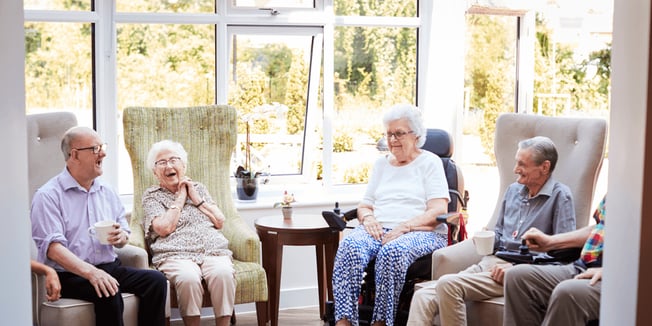Decoding Senior Living: Unveiling 5 Differences Between Assisted Living and Independent Living

The aging journey is as unique as you are.
For some people, the second half of life is a time of renewed interest in health and well-being, a chance to give back to the community, and a time of increased wisdom. For others, anxiety about finances, health, and the challenges of aging undermine their quality of life. Many people find themselves bouncing back and forth between the two extremes.
No matter who you are, what you love, or what your hopes are for the next chapter of life, you deserve to feel safe, happy, and valued.
Assisted living and independent living can each help you attain those goals—but which is the right choice for you?
What Are Assisted Living and Independent Living Communities?
Assisted living and independent living, in many ways, offer similar lifestyles. At Cedarhurst communities, both lifestyle options boast exceptional dining, plenty of social activities and on-site amenities, and a chance to focus on the things that matter most while our helpful, friendly staff handles things like home maintenance and cleaning.
There are also important differences between the two lifestyle options. Independent living caters to healthy older adults who do not need help with activities of daily living, while assisted living offers ongoing daily support.
The two are distinct, but they also exist on a continuum. A person who begins in independent living may eventually transition to assisted living if their daily care needs change. This option is great for seniors who want to remain in a familiar community, stay close to loved ones, and avoid significant transitions. So if you’re considering independent living, also consider how moving now could support a better quality of life over the long term.
Which Type of Senior Living Community Is Right for Me?
Given the differences between these types of communities, how do you determine which is right for you? Here are five factors to explore.
1. Overall Health
Independent living communities are perfect for seniors who do not need help with activities of daily living (ADLs). People move to independent living because they want an all-in-one lifestyle, easy access to activities and amenities, less house maintenance, more time to focus on their interests and activities, and a simplified budget. Independent living can also offer security and reassurance—for example, you know someone is on hand to assist if you fall, and this knowledge can support greater independence.
Assisted living offers all of these benefits, but also includes daily assistance to seniors with chronic health conditions or ongoing support needs. The support you receive is all about your comfort, your well-being, and preserving your independence. Moving into assisted living doesn’t mean you’re giving up privacy; it means you’re gaining extra assistance to maximize your well-being and independence.
Not sure which lifestyle option is right for you? We've got a quiz for that. Answer a few questions
to get direction from our experts.
Take the Quiz
2. Daily Support Needs
The availability of daily support is the core difference between independent living and assisted living. People in independent living outsource many daily tasks such as landscaping, meal preparation, cooking, and even cleaning. However, independent living communities do not offer support with personal care such as bathing.
For adults who want to outsource tasks, enjoy a range of social events and activities, and receive support with ADLs, assisted living is a great choice. In assisted living, you can get help with:
- Cooking
- Bathing
- Getting into or out of bed
- Dressing
- Personal grooming
- Other activities of daily living, as needed
If you’re struggling with self-care or already hire in-home help, assisted living is likely the right choice. If you’re only looking for more fun, less stress, and maximized independence, consider independent living.
3. Continuum of Care
Many people assume that assisted living residents are totally dependent on daily support—they can’t spend time alone or need help with all ADLs. The truth is that assisted living is not one-size-fits-all.
Most assisted living residents just need a little support to maintain their independence. For example, you might find that bathing is becoming more precarious because of osteoarthritis or worry about falling because you have osteoporosis. If so, assisted living could be the perfect choice because it means you’ll have someone on-hand to help during those activities.
As your needs change and evolve, so can the support you receive. Assisted living scales up or down to adapt to your preferences. You’ll get only the help you need, nothing more.
Independent living offers a high degree of respect for your privacy, but it does not include daily care. Choose independent living if you’re only interested in more peace of mind and less stress with daily chores and home maintenance. Assisted living is the right choice if you know you need help with one or more activities of daily living.
4. Daily Activities
In Cedarhurst communities, both independent living and assisted living offer a vibrant, active lifestyle, an activity calendar with plentiful opportunities to socialize and make new friends, exceptional meals, and so much more.
These features are more than mere amenities—they’re good for your health and well-being. Research shows that an active lifestyle can prevent a wide range of health conditions, and a rich social life may be the most important modifiable lifestyle factor influencing long-term health and well-being.
The right senior living community isn’t just a balm to your spirit; it’s great for your health and could even prolong your independence. The key difference between independent living and assisted living is that people in assisted living might need help getting dressed, getting downstairs, or navigating a community’s daily offerings.
5. Cost
Many people learn all about the benefits of the right senior living community, get really excited about the prospect, and then worry that the price will dash their hopes. Rest assured, senior living is more affordable than you may realize, and there are many ways to pay for it.
Some seniors are delighted to discover that a senior living community’s all-in-one pricing means they actually end up paying less for an active lifestyle. Consider the fact that you’ll no longer be paying your old rent or mortgage, and entertainment is now rolled into monthly community fees instead of being a regular out-of-pocket expense. Daily support, too, is included in the cost of assisted living, which can be far less expensive than paying an in-home health aide.
Independent living caters to seniors who do not have complex medical needs and who do not need help with ADLs. Because it provides fewer hands-on services, it may be more affordable than assisted living.
Assisted living offers an expanded range of services, including daily support and assistance. For this reason, it’s often more expensive—but an additional distinction may offset the costs. Because assisted living can qualify as a medical need, various insurance and benefits programs can defray the costs. For example, long-term care insurance may cover assisted living, as might some other insurance policies.
Need more help exploring your options? Check out our free guide, Understanding Senior Living Lifestyle Options, to learn more! Our “Is it the Right Time for Senior Living” assessment can also help you weigh whether it’s time to consider the move.
This post was originally published in June 2023 and updated in October 2023.






.png?width=307&height=200&name=Blog%20%2333%201400%20x%20700%20(1).png)

.png?width=307&height=200&name=Blog%20%2332%201400%20x%20700%20(8).png)



